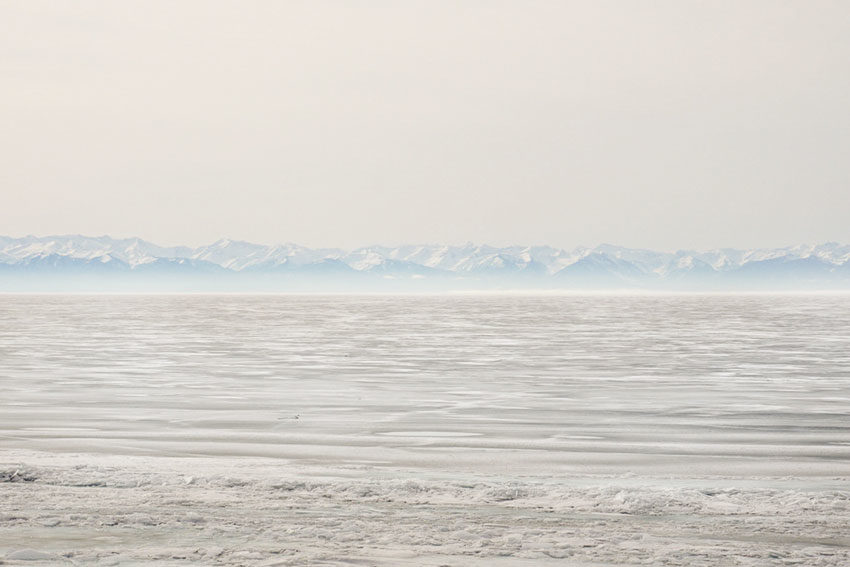Daytripping in Siberia

Half way along the Tran-Siberian Railway, we take a detour to walk on water.
Travelling east to west along the Trans-Siberian Railway, a passenger will cross approximately 100 degrees of longitude – nearly a third of the way around the globe. As the crow flies, the distance between Vladivostok and Moscow is 6412 km, but the train is no crow.
In fact, the journey stretches over 9200 km, carving a crooked passage through Siberia’s 1.3 billion hectares. First, head north from Vladivostok, the largest Russian city over the border from North Korea, and then meander south, curving around China. The tracks run close to the southern edge of Russia – spy Mongolia and then Kazakhstan out the window as the journey progresses.
In March, the wilderness begins to thaw. Bare trees and hardy shrubs poke their twiggy fingers out of frost banks that glow pink and orange in the early morning light. The wide white plain of winter’s snow leads right to the feet of looming blue mountains. Onion domes of orthodox churches sprout out of streets lined with dark wooden houses.
Ride ‘straight’ from Vladivostok for three days to arrive in Irkutsk, one of the largest cities in Siberia and the home of the exiled Decembrists. Irkutsk is a destination worth exploring, but an additional two hours’ drive will deliver you to Listvyanka, a town on the edge of one of Earth’s most ancient marvels.
Lake Baikal is the world’s largest, oldest and deepest freshwater lake. It formed 25–30 million years ago in a rift between tectonic plates. This banana-shaped lake is long and skinny, stretching 630 km north from Listvyanka, but measuring only 70 km at its widest point. Its incredible depth (1.6 km) accommodates its extraordinary volume: nearly a quarter of the world’s fresh surface water is contained in Lake Baikal.

When we arrive in March, the lake surface is still frozen solid. As we drive along the esplanade, we spot people fishing through holes cut in the ice. When the weather is truly cold, and the ice at its thickest (up to two metres), you can spend a day out on a dogsled adventure, or watch artists carving sculptures. Each February, an extreme endurance race is held on the ice, with skaters and bike riders competing to cross 200 km in as little time as possible; this year’s winner completed the marathon on foot in only eight hours.
We have no marathon plans; climbing the steep streets – perilously slippery with slick ice – is enough of an endurance slog. We stay at a guesthouse halfway up the hill, about 15 minutes’ walk from the lake edge. Everything is in walking distance, really: the fish market, the crystal museum and the Nerpanary – a special aquarium dedicated to Lake Baikal’s most beloved residents, the unique nerpa seals.
But first things first: we must set foot on the ice. The surface of the lake is crunchy with a crust of snow, and we revel in the novelty of walking on water. But the Listvyankans do us one better: how about a hovercraft? These neat machines are buoyed on a cushion of air, powered by the thrust of an industrial fan. We scramble into one and hand over 500 roubles (about $10) to the couple inside. In an instant, we’re zipping across the ice, skimming at super speed further and further from the shore. A few hundred metres out, we slow to a stop, climb out of our craft and step onto the middle of the lake.
Imagine 1.6 km, running vertically into the sky from where you’re sitting. That’s Adelaide’s Square Mile, tipped on its edge; it’s all water, silt, and sleek black seals, and we’re standing on top of it. We take a photo in this impossible place, our driver finishes his cigarette, and we hop back in and head to shore.
It’s a small town, and over two days we see most of it: the art gallery, ravaged by bushfire nearly a decade ago; the natural history museum and its two resident nerpa; the lookout accessible by a long walk, a ski-lift and a further stroll. We try piroshki from the fish market – hot, greasy doughballs stuffed with onion and potato – and try the local take on sashimi – frozen chunks of sig, a firm white fish.
All too soon, we’re back in the car on the road to Irkutsk for the next part of our journey. It’s not the easiest place to get to, but Lake Baikal is one of a kind. If you find yourself in Siberia one day, take a daytrip, hit the ice and walk out onto one of the world’s oldest wonders.